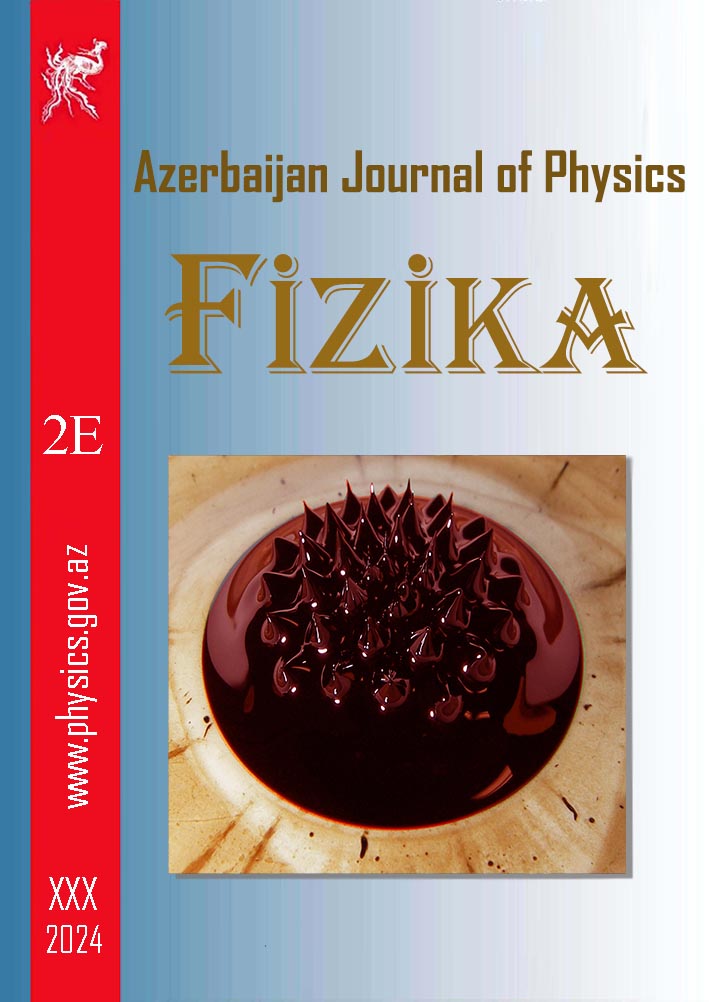ABSTRACT
Visual models of Au48 gold and Ag48 silver nanotubes with a diameter of 0.54 nm and a length of 1.58 nm have been constructed. Based on these models, computer
calculations of the electronic structure were performed using the extended Hückel method. It was found that the Au48 nanotube is a soft, electrophilic,
narrow-band semiconductor (Eg = 0.06515 eV) stable, diamagnetic material, the wavelength of the emitted photons is λ = 0.2 μm. Debye and melting points
are 127.1 K and 793.14 K, respectively. The Ag48 nanotube is a soft, electrophilic, broadband, semiconductor (Eg = 0.48214 eV) stable, diamagnetic
material, the wavelength of the emitted photons is λ = 2.6 μm. Debye and melting points are 123.6 K and 372.74K, respectively. Au48 gold nanotubes are 5 times stronger
than conventional gold materials, and Ag48 silver nanotubes are 4 times stronger.
Keywords: metal nanotube, mathematical model, Extended Hückel method.
PACS: 07.05.Tp; 81.07.-b; 03.67.Lx
DOI:-
Received: 05.04.2021
AUTHORS & AFFILIATIONS
Military Academy of the Armed Forces of the Republic of Azerbaijan
E-mail: gasqhapk@gmail.com
|
REFERENCIES
[1] Umair Shamraiz, Bareera Raza, Hidayat Hussain, Amin Badshah, Ivan R. Green, Farwa Ahmad Kiani & Ahmed Al-Harrasi. Gold nanotubes and nanorings: promising candidates for multidisciplinary fields. International Materials Reviews, 2018, https://doi.org/10.1080/09506608.2018.1554991.
[2] A.Q. Həsənov. AJP FİZİKA, 2019, Series: Az, vol. XXV, № 03, s.43-46.
[3] X. Liu. Extinction coefficient of gold nano-porticles with different sizes and different capping ligands. X. Liu, M. Atwater, J. Wang, O. Huo. Colloids and Sarfaces B: Biointerfaces, 2007. v.58, № 1, p. 3-7.
[4] Г.А. Щембелов и др. Квантовохимические методы расчета молекул. М., Химия, 1980, 255 с.
[5] В.И. Минкин, Б.Я. Симкин, Р.М. Миняев. Теория строения молекул, Ростов-на –Дону: Феникс, 2010, 560с.
[6] Упругие и прочностные характеристики материалов. Доктор Лом. 07.06.2018, http://doctorlom.com/item318.html
[7] A.G. Gasanov, A.A. Bairamov. Physics of the Solid State, -2019. vol. 61, № 1, -p. 208–213.
[8] Dan Guo, Guoxin Xie and Jianbin Luo. J. Phys. D: Appl. Phys. 47 (2014) 013001 (25pp).
[9] Т.П. Черняева, В.М. Грицина, Е.А. Михайлов, А.В. Остапо. Вопросы атомной науки и техники. 2009. № 4-2. Серия: Физика радиационных повреждений и радиационное материаловедение (94), с. 206-217.
[10] A.Q. Həsənov. AJP FIZIKA, 2020. Section: Az, vol. XXVI, № 2, s. 8-12.
[11] M. Ramos, Hardness and elastic modulus on six-fold symmetry gold nanoparticles. Manuel Ramos, Luis Ortiz-Jordan, Abel Hurtado-Macias [et al.] Materials, 6, 2013, p.198-205.
[12] Kai Wu. Magnetic Nanoparticles in Nanomedicine. Kai Wu, Diqing Su, Jinming Liu. et al. University of Minnesota, Minneapolis, Minnesota 55455, USA, November 4, 2018. 67 p.
[13] O.L. Anderson. Journal of Physics and Chemistry of Solids, vol.24, 1963, p. 909-917.
[14] B.K. Pandey. International Journal of Nano-technology and Applications, 2017, vol. 11, № 1, p. 81-90.
[15] A. Bouhemadou. Structural, elastic, electronic, optical and thermal properties of c-SiGe2N4. A.Bouhemadou, Y. Al-Douri, R. Khenata et al. The European Physical Journal B, 71, 2009, p.185-194.
[16] S.K. Gupta, M. Talati, P.K. Jha. Shape and Size Dependent Melting Point Temperature of Nanoparticles. Materials Science Forum, 2008, vol. 570, pp. 132-137, http://www.scientific.net.
|
